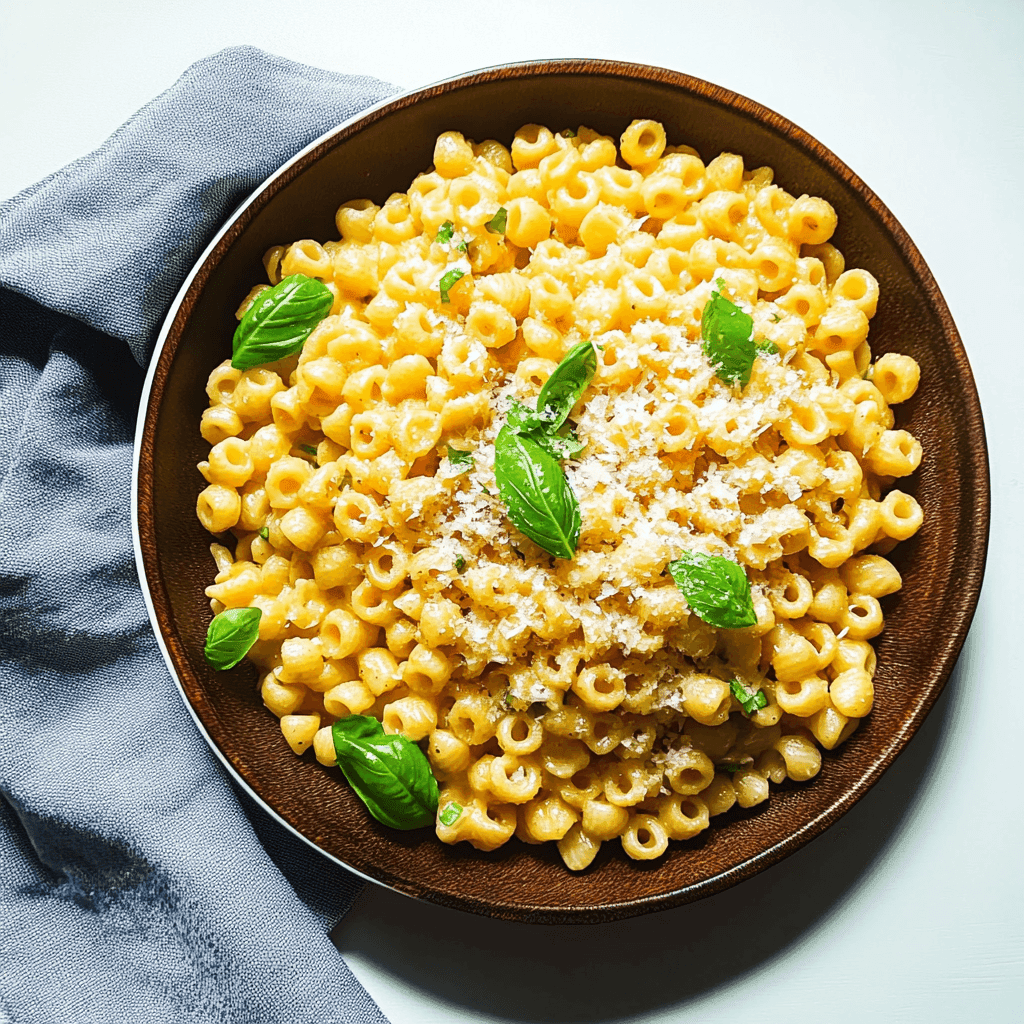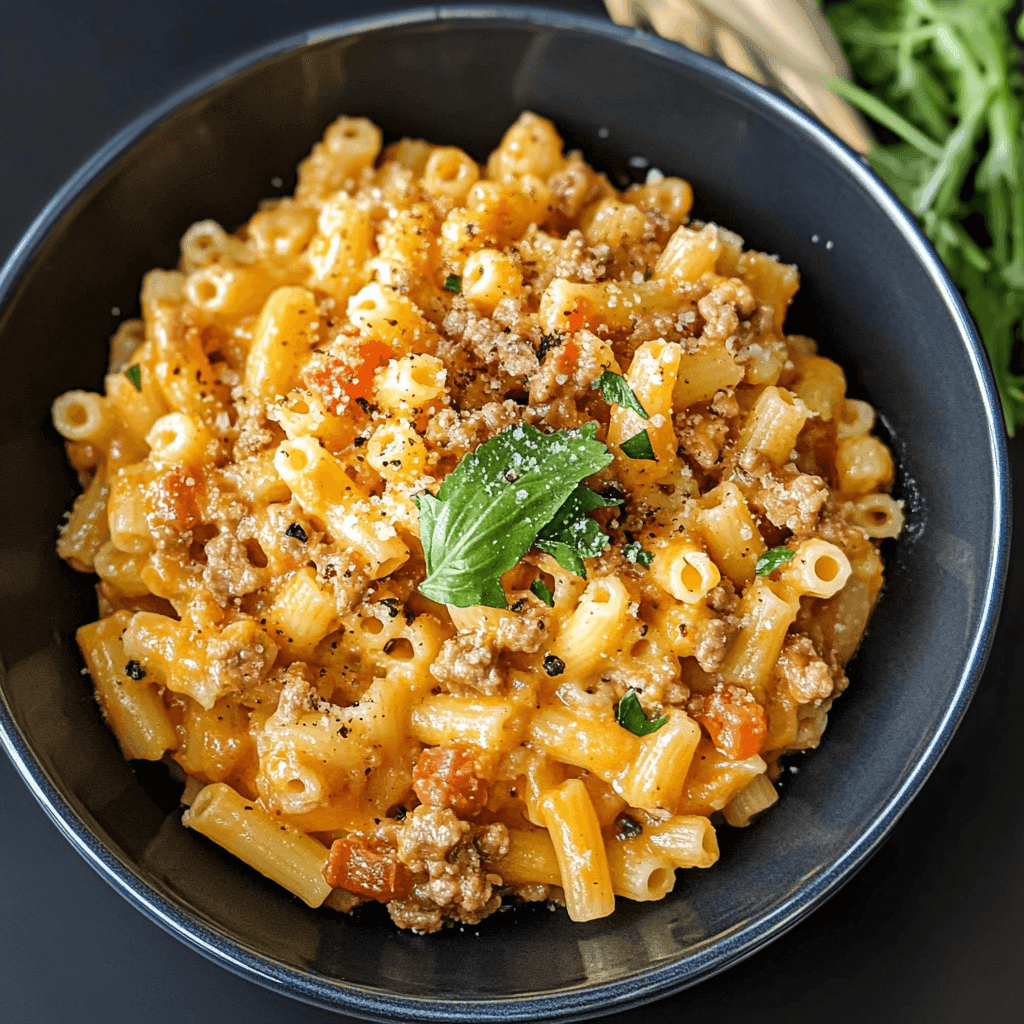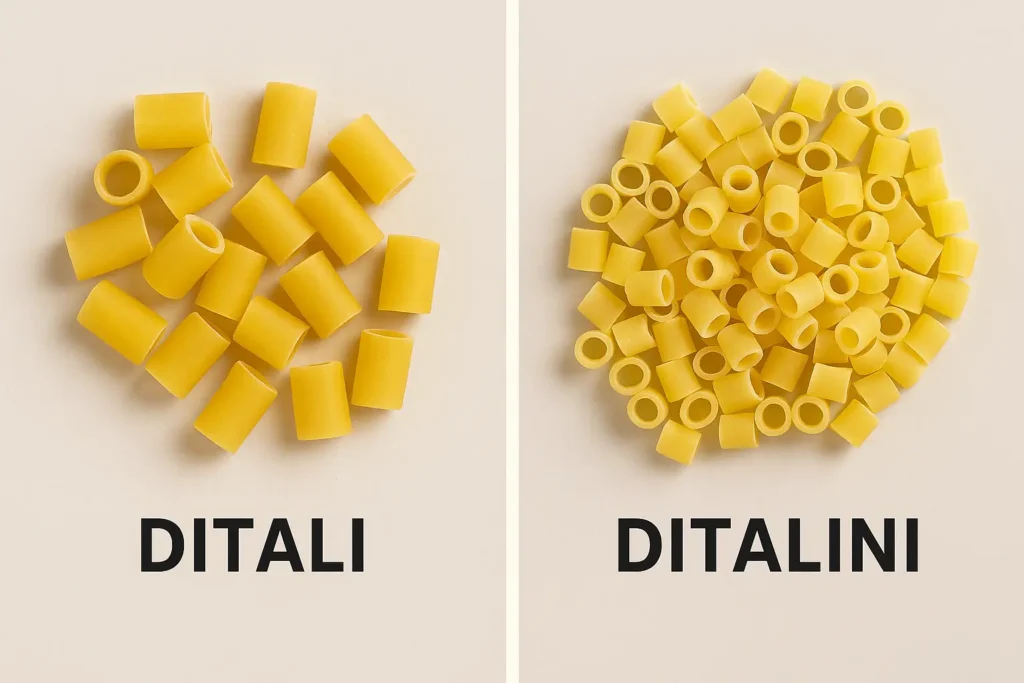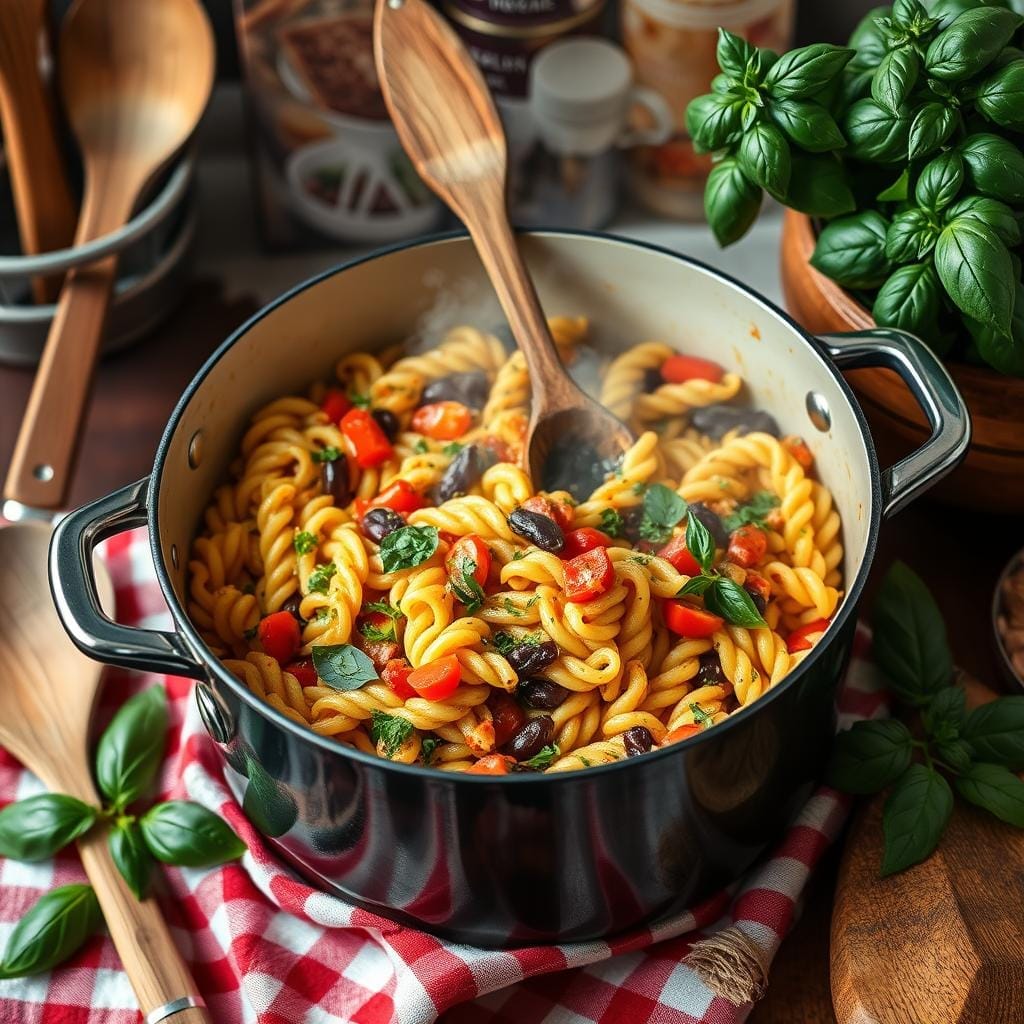The smell of garlic in olive oil fills the air. The feel of al dente pasta is comforting. The flavors of Italy bring back memories. This ditalini pasta recipe is a true culinary delight.
Growing up, my nonna’s Pasta Fagioli was a family favorite. The memories of her cooking still warm my heart. Today, I’m excited to share a version of this dish that brings authentic Italian flavors to your table.

Key Takeaways
- Ditalini pasta is a versatile and comforting ingredient for Italian-inspired dishes
- This recipe combines ditalini with beans, tomatoes, and aromatic herbs for a satisfying one-pot meal
- The dish is easy to prepare and budget-friendly, making it an ideal choice for family dinners
- Customizable ingredients allow you to tailor the recipe to your personal taste preferences
- Leftover ditalini pasta can be enjoyed for up to 4 days, providing convenient meal options
Understanding Ditalini: The Little Thimble Pasta
Ditalini pasta comes from Southern Italy, specifically the Campania region. It looks like tiny thimbles, hence the name “little thimbles.” This pasta is loved for its ability to hold sauces and its tasty texture in many dishes.

Origins and Traditional Uses
The term “ditale” includes larger pasta shapes like ditaloni and ditali. Ditalini, the smallest, is also known as “Garibaldini” after Giuseppe Garibaldi. It’s a favorite in Italian kitchens, especially in Campania, Calabria, and Sicily.
What Makes Ditalini Unique
Ditalini’s shape is great for holding onto sauces and flavors. It’s perfect for soups, salads, and one-pot meals. Its small size gives it a nice, firm texture when cooked right. This makes it versatile for many authentic Italian cuisine recipes.
Perfect Pasta Substitutes
If you can’t find small tube pasta like ditalini, orzo is a good substitute. Orzo, shaped like rice, has a similar small size. It works well in many recipes, even though it looks a bit different.
What Is the Difference Between Ditali and Ditalini Pasta?
Ditali and ditalini pasta may look similar, but their differences affect the final texture and usage in recipes. Ditalini pasta is smaller and more delicate, shaped like tiny thimbles. It’s the go-to choice for soups and light sauces because of how well it blends into each bite without overpowering the dish.

Ditali, on the other hand, is larger and more robust, making it ideal for heartier meals and baked dishes that require pasta to hold its own. This size distinction gives cooks a little flexibility when selecting pasta based on texture, mouthfeel, and sauce compatibility.
Perfect Pasta Substitutes
If you can’t find small tube pasta like ditalini, orzo is a good substitute. Orzo, shaped like rice, has a similar small size. It works well in many recipes, even though it looks a bit different.
Easy Ditalini Pasta Recipe
Essential Ingredients for Authentic Ditalini Pasta Recipe
Making a real ditalini pasta recipe means picking the right ingredients. The base is the ditalini pasta, those small, thimble-shaped noodles. They give the dish a unique texture and look. You also need a few key ingredients for the perfect taste.
For a traditional ditalini pasta, you’ll need Cannellini beans, chickpeas, and pancetta. These add protein, heartiness, and a rich flavor. Don’t forget fresh garlic and Italian tomatoes for the sauce. And, of course, use good olive oil for cooking and finishing.
For a creamy version, add chicken thighs, Parmesan cheese, fresh spinach, heavy cream, and chicken broth. These ingredients make the pasta rich and indulgent. Remember, use real Parmesan cheese for the best taste and texture.
| Ingredient | Quantity |
|---|---|
| Ditalini Pasta | 8 oz |
| Cannellini Beans | 1 (15 oz) can |
| Chickpeas | 1 (15 oz) can |
| Pancetta | 4 oz, diced |
| Garlic | 3 cloves, minced |
| Crushed Italian Tomatoes | 1 (28 oz) can |
| Olive Oil | 2 tablespoons |
With these ingredients, you’re ready to make a delicious ditalini pasta dish. It will be full of Italian flavor.
Kitchen Tools and Equipment Needed
To make a tasty one-pot meal or a quick pasta with ditalini, you need some basic tools. You’ll need a large, high-sided skillet or pot. Also, a wooden spoon or spatula for stirring and measuring cups and spoons for accurate measurements.
Must-Have Utensils
- Large, high-sided skillet or pot
- Wooden spoon or spatula
- Measuring cups and spoons
- Cheese grater for freshly grating parmesan
Optional but Helpful Tools
- Garlic press for mincing garlic
- Lemon juicer for extracting fresh citrus juice
Cooking Surface Recommendations
For the best results, use a non-stick or well-seasoned skillet. This prevents the ditalini pasta from sticking. It helps in cooking the pasta evenly.
Step-by-Step Cooking Instructions
Making a tasty pasta dish with ditalini is easy. Just follow these steps to make a quick pasta recipe full of flavor.
- Start by boiling a large pot of salted water. Add the 16 oz box of ditalini pasta and cook for 10-14 minutes. The pasta should be al dente.
- While the pasta cooks, melt 4 tablespoons of butter in a big skillet. Add 2 tablespoons of flour and mix well to make a roux.
- Slowly add 2 cups of full-fat milk to the skillet, stirring constantly. Add 1/4 teaspoon of nutmeg, 1/2 teaspoon each of garlic powder and onion powder, and a bit of salt and pepper.
- Stir in 2 to 3 cups of shredded cheese until the sauce is smooth. If it’s too thick, add some pasta water to thin it.
- Drain the pasta and toss it with the cheesy sauce. Make sure the pasta is well coated.
- Finally, serve the quick pasta recipe hot. Top it with 1/2 tablespoon of dried parsley and a pinch of black pepper.

By following these easy steps, you can make a delicious easy pasta dish. It’s great for a weeknight dinner or a cozy meal with friends and family.
Creamy Garlic Parmesan Variation
If you’re looking for a rich twist on ditalini pasta, try this creamy garlic parmesan version. It’s perfect for a cozy family dinner. The luxurious sauce will have everyone asking for more.
Special Ingredients
To make this creamy garlic parmesan ditalini, you’ll need some special ingredients. Start by marinating chicken thighs in lemon juice, olive oil, Dijon mustard, and Italian herbs. This adds a lot of flavor to the chicken before it’s cooked.
Cooking Technique
First, cook the marinated chicken until it’s golden and cooked through. Then, set it aside. Next, sauté onions and garlic in the same pan. Add heavy cream, chicken broth, and ditalini pasta, simmering until the pasta is tender.
Finally, stir in spinach and the cooked chicken. Finish it off with a generous helping of shredded parmesan cheese.
Serving Suggestions
Serve this creamy garlic parmesan ditalini hot, garnished with fresh parsley. It’s a comforting meal that will please everyone. Pair it with a fresh salad or crusty bread for a complete Italian-inspired feast.
Classic Pasta Fagioli with Ditalini
Pasta Fagioli is a beloved Italian soup that highlights ditalini pasta. This dish combines the earthy taste of cannellini beans with the delicate ditalini. It’s a true Italian cuisine experience. Get ready to feel like you’re in an Italian kitchen with this ditalini soup recipe.
Start by sautéing diced carrots, celery, and onions in olive oil. Once they’re soft, add a garlic clove. This lets the kitchen fill with its aroma. Then, add a 28-ounce can of whole plum tomatoes, crushing them by hand.
Next, add 4 cups of chicken broth, a parmesan rind, 2 bay leaves, and dried oregano. Let it simmer for 20 minutes. This lets the flavors blend perfectly.
Now, add the ditalini pasta. Cook it until it’s just right. Then, mix in a can of cannellini beans and some fresh basil. This completes the dish.
This classic Pasta Fagioli with Ditalini is not only tasty but also healthy. Each serving has 221 kcal. It’s perfect for a cozy evening or a light lunch. Serve it with Italian bread for a taste of Italy.
| Ingredient | Quantity |
|---|---|
| Ditalini Pasta | 3/4 cups |
| Cannellini Beans | 1 can |
| Chicken Broth | 4 cups |
| Parmesan Rind | 1 |
| Bay Leaves | 2 |
| Dried Oregano | 1 tablespoon |
| Onion | 1 medium, diced |
| Celery Stalks | 2, diced |
| Carrots | 2, diced |
| Garlic Clove | 1 |
| Whole Plum Tomatoes | 1 28 oz can |
| Olive Oil | 1 tablespoon |
| Basil | 1 handful |
This ditalini soup is a true authentic Italian cuisine experience. It combines cannellini beans, ditalini pasta, and aromatic vegetables. It’s a comforting dish that will become a favorite in your kitchen.
Tips for Perfect Al Dente Texture
Getting the perfect al dente texture in your pasta is easy with a few tricks. Whether you’re making a simple pasta dish or trying new shapes, these tips will help. You’ll get that perfect bite every time.
Timing Guidelines
For al dente pasta, cook it 2-3 minutes less than the package says. But remember, homemade pasta cooks differently than store-bought. Start checking it a few minutes before the package’s lowest time.
Water-to-Pasta Ratio
Use a big pot and fill it ⅔ with water. Bring it to a boil on medium-high heat. Aim for 4-6 quarts of water per pound of pasta for even cooking.
Salt and Oil Tips
Adding salt to the water is key for flavor. But don’t add oil, as it stops the sauce from sticking. Use about 1 ½ tablespoons of salt for 4-6 quarts of water. Don’t cover the pot to avoid boiling over.
Follow these tips for perfectly cooked pasta every time. Enjoy your delicious italian pasta with that perfect al dente texture. Happy cooking!
Storage and Leftover Guidelines
Proper storage and handling of leftovers is key for enjoying your delicious ditalini pasta. Cooked ditalini pasta dishes can be stored in an airtight container in the fridge for up to 4 days. This makes it easy to have quick and easy family dinner options all week.
To reheat your leftover ditalini, add a splash of water or broth. This prevents the pasta from drying out. It also helps restore the perfect texture you enjoyed when it was fresh. Ditalini pasta dishes are great for meal prepping, too. You can portion out individual servings into containers for easy quick pasta recipe options during the busy workweek.
However, it’s not recommended to freeze cooked pasta dishes. Freezing and thawing can make the pasta mushy. For the best results, enjoy your leftover ditalini within 4 days of initial preparation. This way, you get to enjoy the maximum flavor and texture.
| Leftover Storage | Reheating Tips | Freezing Advice |
|---|---|---|
| Store in airtight container Refrigerate for up to 4 days | Add splash of water or broth Reheat gently to prevent drying | Not recommended – freezing can cause pasta to become mushy |
By following these simple storage and reheating guidelines, you can enjoy your delicious ditalini pasta dishes for days. Happy cooking and dining!
Conclusion
Ditalini pasta is a versatile and comforting choice for your Italian meals. It’s great in soups, one-pot dishes, or creamy pasta recipes. This pasta’s shape and size make it perfect for absorbing flavors.
With simple ingredients and easy steps, ditalini pasta recipes are ideal for quick dinners or family meals. They capture the heart of Italian comfort food.
Ditalini pasta is perfect for many dishes, from pasta e fagioli to creamy Parmesan recipes. It’s great for a comforting soup or a hearty pasta dish. This ingredient makes your easy pasta dish even better.
It brings authentic Italian flavors to your family dinner table. So, let ditalini pasta be the star of your next meal. Buon appetito!
Print
Ditalini Pasta Recipe
- Total Time: 35 mins
- Yield: 4-6 1x
Description
This Ditalini Pasta Recipe brings authentic Italian comfort to your table with tender pasta, creamy beans, and a rich tomato-herb broth. Perfect for busy weeknights or meal prep, it’s a versatile one-pot wonder that’s hearty, protein-packed, and endlessly customizable. Serve with crusty bread for a cozy family meal!
Ingredients
- 8 oz Ditalini Pasta
- 1 (15 oz) can Cannellini Beans
- 1 (15 oz) can Chickpeas
- 4 oz Pancetta (diced)
- 3 cloves Garlic (minced)
- 1 (28 oz) can Crushed Italian Tomatoes
- 2 tablespoons Olive Oil
Optional for Creamy Version:
Chicken Thighs (marinated in lemon juice, olive oil, Dijon mustard, and Italian herbs)
Parmesan Cheese (freshly grated)
Fresh Spinach
Heavy Cream
Chicken Broth
Instructions
Cook the Ditalini Pasta:
Boil a large pot of salted water.
Add 8 oz of ditalini pasta and cook for 10-14 minutes until al dente.
Prepare the Base:
In a large skillet, heat 2 tablespoons of olive oil over medium heat.
Add 3 cloves of minced garlic and sauté until fragrant (about 1-2 minutes).
Add 4 oz of diced pancetta and cook until crispy.
Add the Beans & Tomatoes:
Stir in 1 (15 oz) can of cannellini beans and 1 (15 oz) can of chickpeas.
Add 1 (28 oz) can of crushed Italian tomatoes. Stir to combine and simmer for 5 minutes.
Combine with Pasta:
Drain the pasta and add it to the skillet with the sauce. Toss to coat.
For Creamy Version (Optional):
Cook marinated chicken thighs until golden and cooked through. Set aside.
In the same skillet, add chicken broth, heavy cream, and fresh spinach. Stir in Parmesan cheese until melted.
- Add the chicken and pasta, toss until creamy.
Serve:
- Serve hot, topped with freshly grated Parmesan cheese and fresh basil (optional).
Notes
Dietary Notes
- Vegetarian Option: Omit pancetta, use veggie broth.
- Gluten-Free: Substitute GF ditalini or small shells.
- Protein Boost: Add Italian sausage or shredded chicken.
- Prep Time: 10 mins
- Cook Time: 25 mins
- Cuisine: Italian
Nutrition
- Serving Size: 1.5 cups
- Calories: 320kcal
- Sugar: 5g
- Sodium: 690mg
- Fat: 8g
- Saturated Fat: 2.5g
- Carbohydrates: 48g
- Fiber: 7g
- Protein: 14g
- Cholesterol: 10mg
FAQ
What is ditalini pasta used for?
Ditalini pasta is great for making Italian dishes. It’s often used in soups, pasta salads, and one-pot meals. Its shape holds sauces well, making it tasty.
What is the difference between ditali and ditalini pasta?
Ditalini is small and tube-shaped, like tiny thimbles. Ditali is a bit larger and cylindrical. Ditalini is more common and used in recipes.
Why is it called “marry me pasta”?
Ditalini pasta is not called “marry me pasta.” This name is likely a local or regional term not widely known.
What pasta is most similar to ditalini?
Orzo is a good substitute for ditalini. It’s small and rice-shaped, great for holding sauces.
What are the key ingredients for a classic ditalini pasta recipe?
A classic recipe includes ditalini pasta, Cannellini beans, chickpeas, pancetta, garlic, tomatoes, and olive oil.
What are the essential tools needed for preparing ditalini pasta recipe?
You’ll need a large skillet, a spoon or spatula, measuring tools, and a cheese grater. Optional tools are a garlic press and lemon juicer.
How do you cook ditalini pasta recipe?
Start by sautéing onions and garlic in olive oil. Add pasta, then chicken broth and cream. Simmer for 10-14 minutes, stirring often, until al dente.
How do you store leftover ditalini pasta dishes?
Store leftovers in an airtight container in the fridge for up to 4 days. Reheat with a bit of water or broth. Don’t freeze cooked pasta as it gets mushy.
Additional Resources to Explore
For those interested in delving deeper into the world of ditalini pasta, the following resources offer comprehensive insights into its history, versatility, and culinary applications:
- Ditalini – The Pasta ProjectThis article provides an in-depth look at ditalini pasta, exploring its origins, traditional uses, and various sizes. It also offers practical tips on pairing ditalini with different sauces and ingredients, enhancing your culinary repertoire.
- Ditalini – Share the PastaThis resource delves into the characteristics and history of ditalini pasta, highlighting its role in traditional Sicilian dishes. It also includes a selection of recipes that showcase the pasta’s versatility, making it a valuable addition to your cooking endeavors.
- Ditalini – ValdigranoThis page offers a concise overview of ditalini pasta, discussing its ancient origins and best pairings. It provides insights into the pasta’s regional significance and suggests ideal combinations to enhance your dishes.
These resources serve as excellent companions to your culinary journey, offering both historical context and practical applications for incorporating ditalini pasta into your meals. For more visit : Recipes Paradise

2 thoughts on “Ditalini Pasta Recipe: A Taste of Italian Comfort”